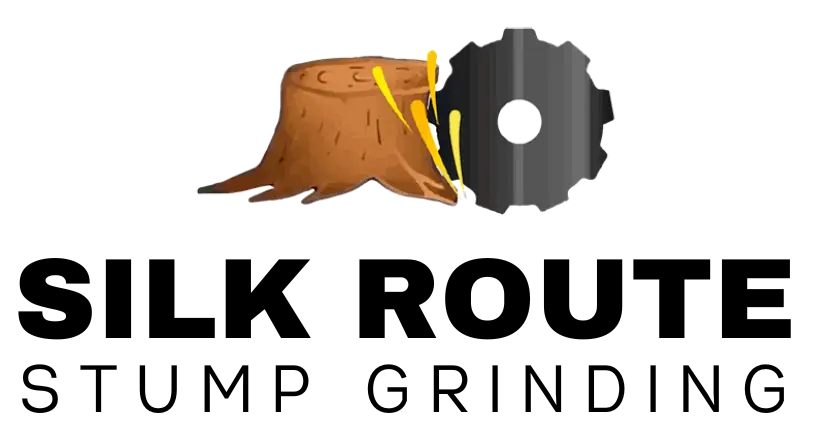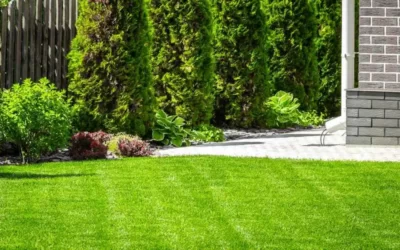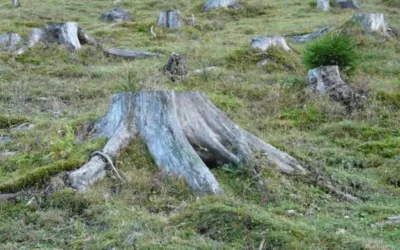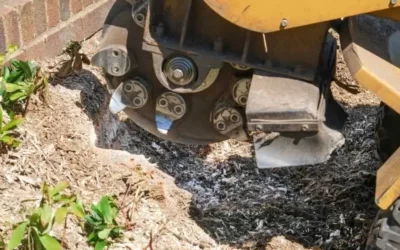While we discuss tree maintenance and tree removal (as we frequently do at Silk Route Stump Grinding), we typically discuss the upper branches that necessitate aerial lift trucks or physical climbing through the canopy, or we discuss the accuracy and safety that are required while pruning or removing trees. Today, we’d want to discuss the portion of the tree that is left behind after a tree is cut down:
A Stump!
Most people recognize that if they don’t deal with the stump right away after a tree is removed, they will be stuck mowing around and dealing with it for a very long time. What can be done, though?
The “do-it-yourselfers” might try to dig it out, pull it out, or even rip it out of the ground because the majority of people have no knowledge of how to go about removing it.
Stump grinding, on the other hand, is a technique used by expert tree care companies to remove unsightly stumps from your property and is a successful one, as we’ll see when we compare it to the alternatives.
Although many homeowners may not even be aware of stump grinding, it may not seem glamorous, but hey, that’s what pros are for. In addition to providing the service, it is our responsibility as a professional tree care company to thoroughly explain and explain the entire process so that you can make the best choice for your property and your budget.
Stump grinding is a procedure that needs to be planned at every level, and when issues do occur, they typically result from fundamental misconceptions about how the process actually works.
Many tree services possess the right tools required to remove stumps. This indicates that they are capable of properly using a stump grinder, but it does not necessarily imply that they can describe in full the service they will offer and, more crucially, how it will go on your land. It should be mentioned that certain companies specialize solely in grinding stumps for customers.
By ensuring that everyone is aware of how the procedure works and has a clear idea of what the property will look like after the stump has been removed, any issues can be avoided.
Here are four considerations for homeowners when choosing someone to grind stumps.
Problem #1 with Stump Grinding: Myths & Misconceptions
Many of the issues individuals have about stump grinding are the result of their having unreasonable or unfounded expectations about how it will go. It might be simpler to correct this by first defining what a stump grinder isn’t.
- Woodchippers are not stump grinders. They do not turn stumps into attractive mulch or fine, useful mulch chips.
- Saws aren’t stump grinders. Stump removal does not result in neat heaps of firewood or sawdust.
- Vacuum cleaners aren’t stump grinders. The shavings are not gathered into a bag or other container for simple disposal.
And what exactly is a stump grinder?
Despite the fact that arborists frequently use a variety of technical terms to describe their techniques and equipment, a stump grinder performs exactly what its name suggests: it grinds stumps out of the ground using hydraulic and mechanical means.
That’s all there is to it.
The stump grinder is a device with a sizable cutting wheel or circular blade. One of our arborists moves it into place, and it is then forced up against the stump. The wood fibers in the stump are ground or pulverized into stringy debris by the grinding teeth’s sharp carbide point.
Although it is huge enough that clearance and right of access may be a problem, it is tiny enough that one person can move into position and operate it. We can work in the majority of areas because we have stump grinders in different sizes.
Solution:
The issue can be resolved by having open communication between the homeowner and the tree service about the equipment’s requirements, capabilities, and limitations. Stump grinders specialize in a single task and excel at it. The process will always be successful if everyone is aware of what that means.
Problem #2 with Stump Grinding: Clean Up
While Silk Route Stump Grinding takes pride in leaving our work sites tidy, safe, and clean, we also respect homeowners’ “do-it-yourself” attitudes and financial limitations.
As a result, our clients have a variety of cleanup alternatives to select from, which are based on their responses to the following inquiries:
How far below grade do the stump(s) need to be buried?
- sufficient depth to sow grass or a lawn? (Roughly 6 to 8 inches deep).
- Can I plant another tree there? (Depending on the age, size, and species of the tree stump, around 12-36 inches below grade).
- Is it deep enough to dig a foundation or footer for construction, a driveway, or both? (set by the contractor based on conditions at the site).
What should be done with the scraps left behind from crushing stumps?
- Leave all waste where it is. This is the “No Cleanup” choice. Although it is the least-priced choice, the homeowner must put more work into it.
- It is placed back into the hole. In order to level the stump grindings with the surrounding grade, we take the stump debris and backfill the stump hole with it. The extra debris from the stump grinding is subsequently removed. This represents the average cost.
- Leaving the hole bare. The hole is left empty after we clear it of all the stump debris. The hole is then prepared for topsoil, new grass, or perhaps another tree to be planted. Due to the fact that it requires the most time and work, this option is the most expensive of the three.
- Possibilities for specialized landscaping. Once the hole is filled, Silk Route Stump Grinding will also provide landscaping options, such as topsoil addition, grass seeding, the use of straw matting or Penn Mulch, etc. These alternatives have higher material and labor expenses.
It’s critical that those who choose to handle the mess left behind by stump grinding understand exactly what they’re signing up for.
Stump grinders are not saws, woodchippers, or vacuums, as we previously stated. The byproducts of stump grinding are stringy fragments of heavy, thick, and acidic wood fibers that are unsuitable for mulch or really any other useful landscaping uses. The grindings may, on rare occasions, be useful for preventing mud on a walking trail, but that is about it.
The stump grindings are also likely to contain the stones, roots, native subsoil, and topsoil that the roots were growing in. The region and the hole where the stump once stood will be surrounded by a loosely stacked pile of this variety of debris.
Solution:
Because we have the equipment and vehicles (such as trucks) needed for the work, we advise letting us handle the nasty mess cleanup. However, if you decide to handle the cleanup yourself, please be aware of the risks involved. Keep in mind that the mess will be enormous and that the grindings are probably not going to be useful for landscaping. Many individuals misjudge the amount of trash they will have to pick up afterward. Even tiny trees may need several truckloads.
Problem #3 Stump Grinding Issue: Visible Surface Roots
You may have noticed that some tree species have shallow-growing root systems in your yard or neighborhood. Anyone who has run into one of these roots while mowing can attest to the harm that they can do to your own mowing equipment. Some of these root systems are evident at grade or higher.
All varieties of maples, hybrid poplars, honey locusts, and willows are a few examples of trees with shallow root systems that only reach 4–8 inches below the surface of the ground. In addition to being shallow, these root systems can reach up to 20 feet from the tree’s trunk. In fact, we’ve seen them extend out as far as 50 feet!
When doing our stump grinding services at Silk Route Stump Grinding, we are trained to locate these surface roots and remove them as well. Sometimes it may be necessary to hack or cut these roots out with a very sharp ax in order to remove them. If they are quite large, further grinding with the stump grinder might be necessary. However, you may be confident that we will make them vanish.
Solution:
For some tree species, the stump removal procedure may be more involved. A professional tree care company’s responsibility is to thoroughly investigate and describe exactly what the end product will look like. After the stump has been ground out, many tree care companies are happy to leave the ground with visible surface roots. They can claim that they are insignificant and that it is outside the purview of their profession. However, history has shown us that our consumers will demand the removal of these unattractive, problematic landscape hazards for both practical and aesthetic reasons. By using Silk Route Stump Grinding, you may get that top-notch outcome without all the fuss.
Problem #4 Root Suckers are Stump Grinding
After the stump is removed and the stump grindings are cleaned up, another type of issue with some trees might only be starting. We already talked about how to deal with “visible” roots, but what about unseen roots?
The amount of the “nonvisible” root system that is preserved beneath the surface of the lawn depends on the size and species of the tree. This saves the homeowner the work of tearing up an area that is roughly the size of the tree’s canopy for some trees because it is OK as is.
However, the roots of some trees (namely fruit-bearing trees, honey locusts, ailanthus, sweet gums, mulberries, hybrid poplars, bamboo, and other exotic species) not only survive but also expand.
The roots don’t need to produce food because they already have enough on hand to support their growth for the next two to three years. The roots themselves started to produce sprouting suckers. It will appear to the homeowner as though they removed one tree, only to have dozens of saplings grow in its place. Unfortunately, there isn’t much that can be done at that time. The sprouts will eventually die off if the homeowner doesn’t continuously cut them off or cover them with grass.
Solution:
After the stump has been ground out, a herbicide treatment must be applied immediately (by a State Certified Applicator or Registered Technician). After the initial tree removal, the treatment must be done within an hour, and we advise doing so within a half hour. The remaining subterranean root system cannot be seen, so the herbicide treatment must translocate/move through the root system for a day or two in order to destroy it.
Conclusion
It is far simpler to deal with potential issues before the procedure starts, as is the case with many parts of tree maintenance, particularly with stump grinding. The process will be successful when everyone engaged is aware of what to anticipate from the process, the cleanup, and the aftercare.
The majority of issues are caused by misunderstandings about the equipment, the method of stump removal, the amount of stump debris produced as a result of the process, or potential post-grinding issues (such as root suckers, which can take years to fix).
Employing businesses that are skilled with the tools, informed about trees, and trained to walk clients through the entire process can help homeowners make the best decisions prior to the removal, preventing issues before they even have a chance to arise.
To talk more about your project for grinding stumps, contact us today.






